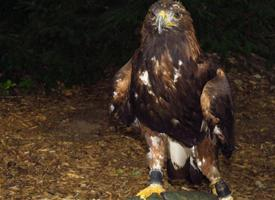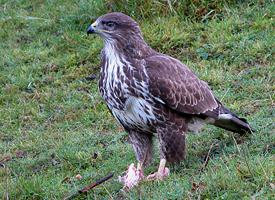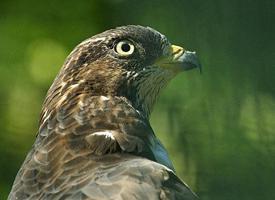
Poids et mesures
| Longueur | de 80 à 90 cm |
|---|---|
| Poids | de 2,8 à 4,5 kg |
| Envergure des ailes | de 195 à 220 cm |
Description de l'animal
The Golden Eagle (Aquila chrysaetos) is one of the most formidable and revered birds of prey across the Northern Hemisphere, where it inhabits a range of landscapes from the vast, unbroken expanses of tundra and desert to the rugged terrains of mountain ranges. This majestic raptor is distinguished by its impressive size, powerful build, and striking plumage, characteristics that have made it a symbol of power and freedom in various cultures throughout human history.Adult Golden Eagles are awe-inspiring creatures, boasting a body length that can range from 66 to 102 centimeters (26 to 40 inches) and a wingspan that can extend up to 2.3 meters (7.5 feet), making them one of the largest birds of prey. Their weight varies between 3 to 6.35 kilograms (6.6 to 14 pounds), with females typically larger and heavier than males. The eagle's plumage is predominantly dark brown, with lighter golden-brown plumage on their napes—an attribute that gives the species its common name. Immature eagles display a more mottled appearance with white patches on their wings and tails, which they gradually lose as they reach maturity around five years of age.
Golden Eagles are solitary and territorial creatures, often seen soaring at high altitudes in search of prey. Their keen eyesight, which is among the sharpest in the animal kingdom, allows them to spot potential meals from several kilometers away. Their diet is diverse, feeding on a variety of mammals such as rabbits, hares, marmots, and ground squirrels, as well as birds, reptiles, and carrion. They are skilled hunters, capable of reaching speeds of up to 320 kilometers per hour (200 miles per hour) in a dive, using their powerful talons to capture and kill their prey.
Breeding pairs of Golden Eagles are monogamous and may remain together for several years or even for life. They favor cliff faces, tall trees, or human structures for nesting sites, where they build large nests of sticks, vegetation, and animal fur. The female typically lays two eggs, although it is common for only one chick to survive due to the natural occurrence of siblicide, where the older, stronger chick kills its sibling. Both parents share responsibilities in incubating the eggs and feeding the young.
The Golden Eagle's habitat is as varied as its diet, ranging from the open tundras and desert plains to dense forests and mountainous regions. They are highly adaptable birds, capable of thriving in a wide range of environmental conditions as long as there is sufficient prey and suitable nesting sites. Despite their adaptability, Golden Eagles face threats from human activities, including habitat destruction, poisoning from lead and pesticides, and collisions with wind turbines and power lines. Conservation efforts are in place in many areas to protect these magnificent birds and their habitats.
Revered for its strength, agility, and beauty, the Golden Eagle has held a place of honor in many cultures throughout history, symbolizing courage, freedom, and even divine power. It is featured in folklore, religious texts, and heraldry, a testament to the deep impression this majestic bird of prey has left on human imagination and spirit.
In summary, the Golden Eagle is a remarkable bird of prey, known for its size, power, and beauty. Its presence across diverse landscapes highlights its adaptability and the important role it plays in maintaining the balance of ecosystems. As a symbol of wildness and freedom, the Golden Eagle continues to captivate and inspire humanity, reminding us of the importance of conserving the natural world and its magnificent inhabitants.
Carte de répartition

Animaux similaires
Nouvelles photos d'animaux
Top 10 des animaux
- Dolphin gull (Leucophaeus scoresbii)
- Japanese macaque (Macaca fuscata)
- Stone loach (Barbatula barbatula)
- Greek tortoise (Testudo graeca)
- Russian tortoise (Testudo horsfieldii)
- Galápagos tortoise (Geochelone nigra complex)
- Diana monkey (Cercopithecus diana)
- Moustached guenon (Cercopithecus cephus)
- Common flying dragon (Draco volans)
- Galápagos penguin (Spheniscus mendiculus)


